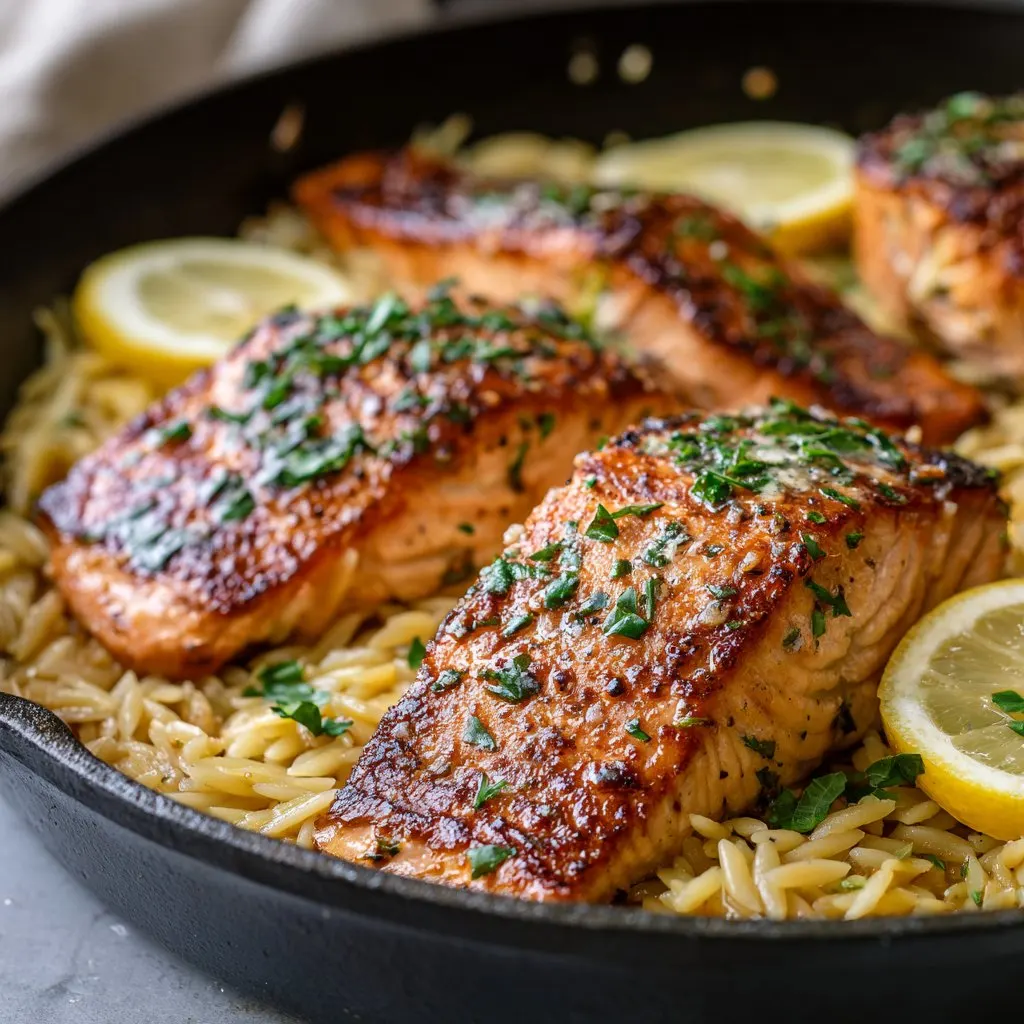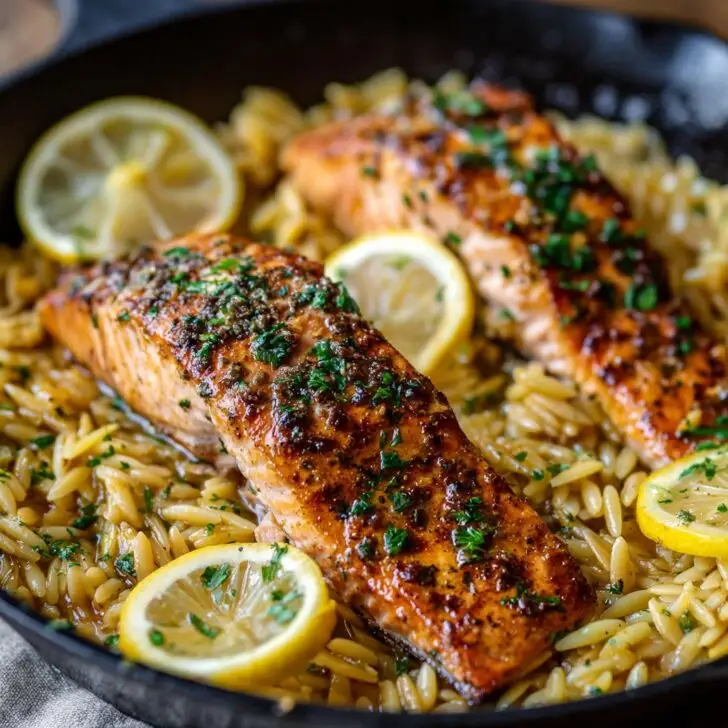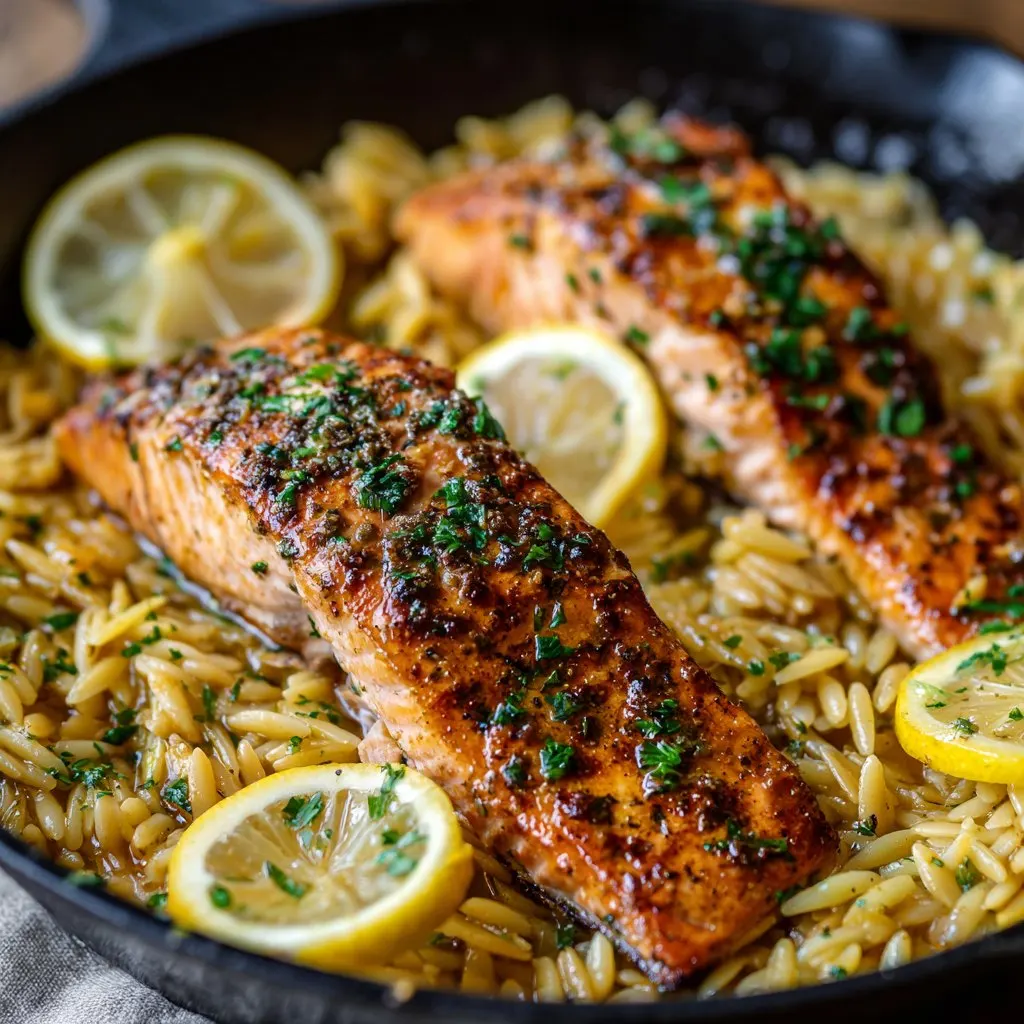Let Me Tell You Why I Keep Coming Back to This Salmon Orzo
You know those nights when you open the fridge and just stare, wondering what on earth to throw together, but you really don’t want to clean more than one pan? That’s basically how this One Skillet Salmon with Lemon Garlic Orzo was born at my place. (Well, that and a stubborn craving for something fancier than my usual Tuesday fare.) First time I tried it, the orzo turned mushy, but the salmon was so good I almost didn’t care. Now, after a few tweaks (read: trial, error, and a fair amount of muttering), I think I’ve nailed a version that hits all the right notes. Might not be the prettiest thing the first time, but hey, neither was my first pancake.
Why You'll Love This (or at Least Why I Do)
I make this when I want to feel like I've put in some effort, but really haven’t. My family goes crazy for this because it’s got that zippy lemon thing going on, and the orzo soaks up everything like it’s been training for a marathon. Also, you get your protein, carbs, and veg all in one go—less washing up, more time for literally anything else (and yes, I’ve ruined other one-pan meals before, but this one is nearly foolproof). Oh, and if you’re a fan of leftovers, I think this actually tastes better the next day, but it’s usually gone before I get the chance to prove it.
Ingredients (Swaps & Tips Included!)
- 4 salmon fillets (I usually go with skin-on, but skinless works fine—my brother swears by frozen wild salmon, which is totally fine if that’s what you have)
- 1 ½ cups orzo pasta (sometimes I sub with pearl couscous if I’m out; not the same, but still good)
- 2 tablespoon olive oil (or just use butter—my gran always did, and honestly, anything works if you’re desperate)
- 3 cloves garlic, minced (if you love garlic, throw another one in, I won’t judge)
- Zest and juice of 1 large lemon (or 2 small; or a splash of bottled lemon juice if you’re in a pinch)
- 3 cups chicken or veggie broth (sometimes I use water with a bouillon cube—no shame in that game)
- 1 small zucchini, diced (or a handful of spinach, or honestly any veg trying to escape the crisper)
- ½ cup peas, frozen or fresh (optional, but I like the pop of color)
- Salt & black pepper, to taste (but remember your broth might be salty already)
- Fresh parsley or dill, chopped, for serving (totally optional but looks fancy)
How I Usually Throw It All Together
- Pat your salmon dry and sprinkle with salt and pepper. (This is the step where I always manage to get fish bits on my sleeve. Every. Single. Time.)
- Heat up a big skillet (I use my trusty cast iron, but honestly, a regular nonstick is fine) over medium-high. Drizzle in the olive oil, then place the salmon skin-side down. Sear about 3 mins, then flip for just another minute. You’re just aiming for golden, not cooked through. Take 'em out and set aside—don't eat it yet!
- Add a bit more oil if needed, then toss in the minced garlic. Let it sizzle (don’t burn it!) for about 30 seconds. Then in goes the orzo. Toast it, stirring, for a minute or two. Smells so good here—this is where I usually sneak a taste, even though it’s nowhere near ready.
- Pour in the broth and lemon juice, add the zest, and bring it to a gentle simmer. Stir in your zucchini and peas (or whatever green thing you found). Give it a big stir, then nestle the salmon back on top, skin-side up if it has skin. Cover the skillet (if your skillet doesn’t have a lid, foil works—learned this the hard way) and let it simmer gently for about 10–12 minutes. The orzo should be soft but not mush, and the salmon just cooked through. Don’t worry if it looks a bit weird at this stage—it always does!
- Remove from heat and let it sit, uncovered, for a couple minutes (this helps the orzo absorb any excess liquid, and honestly, I use this time to pour myself a glass of something cold).
- Top with herbs if you fancy, then serve straight from the pan. No point dirtying another dish, right?
Random Notes from My Many Tries
- Don’t panic if your orzo sticks a bit—just scrape it up and pretend it’s intentional flavor.
- Actually, I find it works better if you don’t overcrowd the pan; the orzo cooks more evenly that way.
- If the salmon breaks up while moving it, that’s fine. Call it rustic and move on.
Variations I’ve Tested (and One Flop)
- Sometimes I swap zucchini for asparagus tips, or chuck in cherry tomatoes. Both ace.
- I tried swapping all the broth for coconut milk once and... eh, not my favorite. Tasted like salmon pudding. Wouldn’t recommend.
- If you’re not into salmon, chicken thighs work, but you’ll have to cook them longer at the start. (And honestly, it's not as quick then!)
About the Gear (a Little Cheat if You Need One)
I use my battered old cast iron, but a big nonstick pan works just as well. And if you don’t have a lid, like I said, foil is a fine stand-in. Or in a pinch, I once used a pizza pan on top. Don’t recommend that, but it worked.

How Long Does It Last? (Not Long in My House)
This keeps in the fridge for up to two days, sealed in a container. Though, honestly, it rarely gets past the first day here—someone always snags the leftovers at midnight. Reheat gently with a splash of broth or water so the orzo doesn’t turn into a brick.
Serving Ideas (Here’s What I Do)
I serve it straight from the skillet (lazy, but also kind of charming). Sometimes with a big salad if I’ve got the energy, or just a hunk of bread to mop up the lemony sauce. My sister dumps on extra parmesan, which is technically not traditional, but who cares—rules are for other people.
Pro Tips I Only Learned by Messing Up
- Once I tried rushing the toasting step for the orzo. Regretted it—the flavor just wasn’t there. Take the two minutes, trust me.
- If your salmon looks a little dry on top, drizzle a bit of olive oil before serving. Makes all the difference.
- Don’t forget to zest the lemon before you cut and juice it. I always forget, and then I’m left scraping at lemon halves like a fool.
FAQ (Real Questions, Real Answers)
- Can I use brown rice instead of orzo?
- Honestly, I wouldn’t. Brown rice takes forever and the timing’s all off. But hey, you can try—just give yourself extra time and patience.
- Does the salmon have to be fresh?
- Not at all. I’ve used frozen fillets plenty (just thaw them first). I like the wild ones from Vital Choice, but whatever’s on sale works.
- Can I make this dairy-free/gluten-free?
- Yep! Use gluten-free orzo (like Bionaturae) and olive oil instead of butter. Otherwise, nothing to worry about.
- What if I don’t have orzo?
- Small pasta shapes like ditalini or even broken spaghetti will do in a pinch. It won’t be quite as creamy, but still tasty.
(Quick unrelated sidetrack: the first time I made this, I put the skillet on the wrong burner and wondered why it wasn’t getting hot. Turns out, you actually have to turn on the right knob. Who knew?)
Still hungry? I pick up a lot of my pantry staples from Thrive Market, if you want to browse around. Or if you’re curious about cast iron care, check out Lodge’s tips—I learned a trick or two there.
Ingredients
- 4 salmon fillets (about 6 oz each)
- 1 cup orzo pasta
- 2 tablespoons olive oil
- 3 cloves garlic, minced
- 1 lemon, zested and juiced
- 2 cups low-sodium chicken broth
- 1 cup baby spinach
- ½ teaspoon salt
- ¼ teaspoon black pepper
- 2 tablespoons chopped fresh parsley
Instructions
-
1Season the salmon fillets with salt and black pepper on both sides.
-
2Heat 1 tablespoon of olive oil in a large skillet over medium-high heat. Add the salmon fillets, skin-side down, and cook for 3-4 minutes per side until golden and just cooked through. Remove salmon from the skillet and set aside.
-
3Add the remaining olive oil to the skillet. Sauté the minced garlic for 1 minute until fragrant.
-
4Stir in the orzo and toast for 1-2 minutes. Pour in the chicken broth, lemon zest, and lemon juice. Bring to a simmer and cook, stirring occasionally, for 8-10 minutes until the orzo is tender.
-
5Stir in the baby spinach and cook until wilted. Return the salmon fillets to the skillet, nestling them into the orzo. Cook for 2-3 minutes to heat through.
-
6Garnish with chopped parsley and serve immediately.
Approximate Information for One Serving
Nutrition Disclaimers
Number of total servings shown is approximate. Actual number of servings will depend on your preferred portion sizes.
Nutritional values shown are general guidelines and reflect information for 1 serving using the ingredients listed, not including any optional ingredients. Actual macros may vary slightly depending on specific brands and types of ingredients used.
To determine the weight of one serving, prepare the recipe as instructed. Weigh the finished recipe, then divide the weight of the finished recipe (not including the weight of the container the food is in) by the desired number of servings. Result will be the weight of one serving.
Did you make this recipe?
Please consider Pinning it!!


